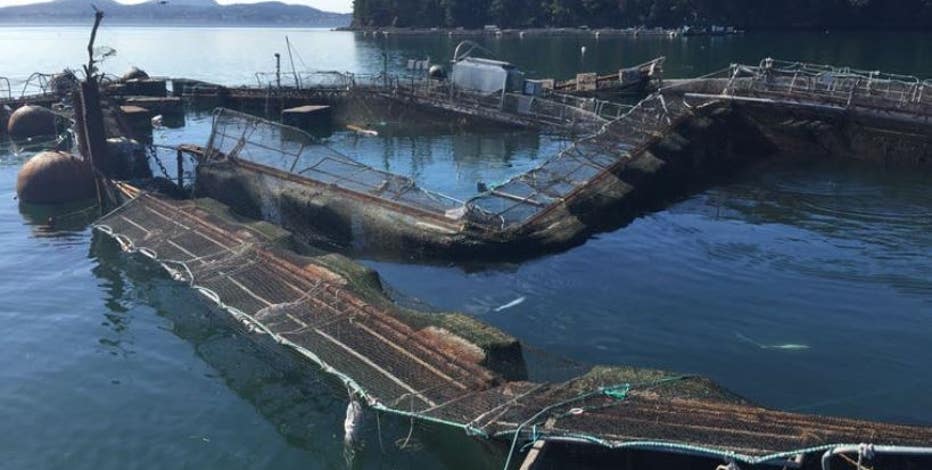One year later: Understanding last year’s heat dome, and its toll on countless shellfish
SEATTLE - As extreme heat grips the Pacific Northwest, it’s hard to forget the record-setting heat dome that struck the region on this same week one year ago.
While the immediate effects included human loss and wildfires, scientists working beaches throughout British Columbia and Washington’s coast also saw marine life loss climb at a rapid pace.
"It just hit us; this was more intense than normal," explained UW research scientist Wendel Raymond, the lead author of a research paper reviewing the shellfish impacts of the 2021 heat dome.
Raymond works out of UW's Friday Harbor Laboratories, but in this case the effects of the heat dome reached throughout the Salish Sea – both in Canada, and Washington's coast. His team worked with people from central Canada down to Willapa Bay, Washington including tribes, nonprofits, local and state governments.
That work became a study which was just published in the Journal of Ecology, describes a perfect storm—the lowest tides of the year, paired with a rare heat event, baking tens of thousands of shellfish.
What we learned
As Raymond explained to FOX 13 News, shellfish dying is normal to an extent, but the scope of the death in 2021 was beyond what biologists were used to seeing. The same marine life dying off are used to heat and tides, and even resilient to a degree.
"So, the fact that there was mortality on top of that really highlights that these organisms were pushed far beyond their physiological limits," said Raymond. "That’s why they died."
Species that were on the inland coast suffered, on average, the largest mortality events.
The outer coast saw low tide earlier in the day, meaning the water was going back out when the hottest weather hit.
However, the individual makeup of various beaches seemed to offer additional resilience.
"On one beach, maybe the oysters seemed to get hit really hard, but just up the road they appeared okay—separated by only a few miles," said Raymond. "That’s really interesting, and the scientist in me is asking, ‘Well, why?’"
A glimmer of hope
That survival offers a glimmer of hope, especially with what’s to come.
In the early days following the 2021 heat dome, researchers with the World Weather Attribution network determined that the conditions we saw were "virtually impossible without human-caused climate change."
They also noted that these events will be less rare, as warming trends continue.
"It was a huge learning experience for us," said Alana Quintasket, siwəlcəʔ, a Swinomish Senator. "We’ve experienced this now. How do we learn to respond to this? This is only the beginning. We need to learn to be adaptable in these circumstances."
Quintasket said the initial reaction to forecasts was a concern for human life, but as marine life died off on Swinomish beaches, the concern shifted to shellfish.
"Shellfish are our way of life," she said. "We’ve only been able to survive here since time immemorial because of the shellfish. When there’s times in the year when the fish aren’t running, or there isn’t game, that’s what we depend on."
Marine life are akin to relatives in the water – as such, Swinomish people are stewards of that land. It’s why the tribe put out a climate change plan in 2007, far before non-tribal governments were adapting such plans. Quintasket said the path forward must be one of adaptation, so that they don’t lose their livelihood or way of life.
"How are we going to be able to provide for our people—not just this year, but what is it going to do for next year, next generation and so on," she asked. "We have to ask when we have children, ‘Will they be able to taste what the clams taste like coming from the land we come from?’"
What's next
"It’s highly likely it’ll happen again," said Julie Barber, a collaborator on the new study.
Barber serves as the senior shellfish biologist for the Swinomish Indian Tribal Community. According to her, some beaches proved to be resilient, despite being surrounded by high-mortality event areas.
While this latest study sets a baseline of knowledge from the 2021 event, it also serves as a leaping off point for other studies reviewing the event. Barber and Raymond noted that oyster and clams, and their resilience in some locations versus others, has piqued their interest.
"So, moving forward from a science perspective, we’ve created a group of scientists and co-managers that’ll continue to speak with each other and maybe come up with better plans on how to react when a forecast like this occurs," said Barber.
Featured
Jury awards $595,000 to Lummi tribe for salmon pen collapse
A Washington state jury on Wednesday awarded the Lummi Indian tribe $595,000 over the 2017 collapse of a net pen where Atlantic salmon were being raised — an event that elicited fears of damage to wild salmon runs and prompted the Legislature to ban the farming of the nonnative fish.
Get breaking news alerts in the FREE FOX 13 Seattle app. Download for Apple iOS or Android. And sign up for BREAKING NEWS emails delivered straight to your inbox.
In the meantime, there are real-world impacts still unfolding. The Swinomish people won’t be harvesting cockles from some beaches after they died off in large numbers. What future harvests bring is a lingering question, until researchers understand how reproduction worked before, during and after the heat dome event.


